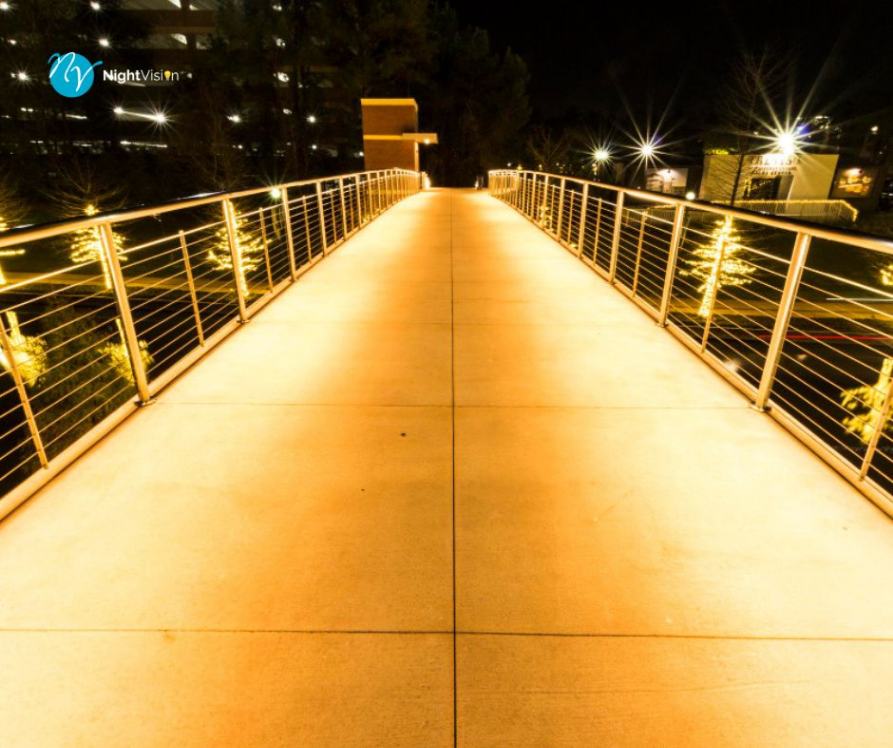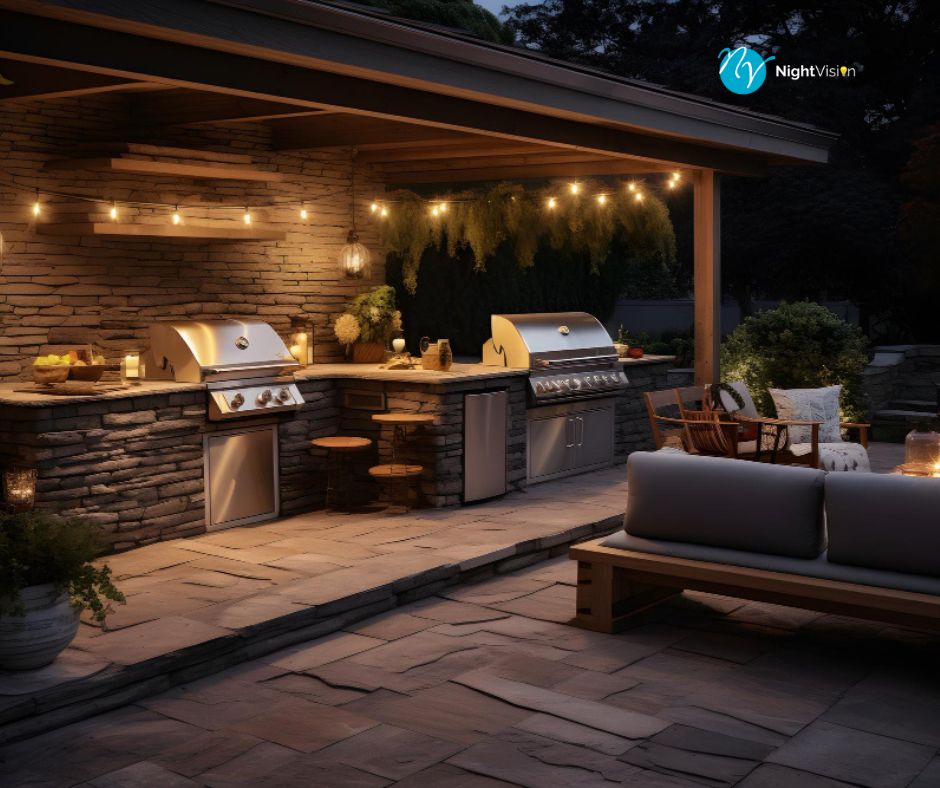Alfresco dining and cooking have become increasingly popular, blurring the lines between indoor and outdoor living spaces.
Outdoor kitchens offer a unique opportunity to entertain guests and enjoy culinary adventures under the open sky.
However, proper lighting is essential to ensure these spaces are not only functional but also stylish and inviting.
In this article, we’ll explore various outdoor kitchen lighting ideas that strike the perfect balance between functionality and aesthetics.
Consider the Layout
Before delving into specific lighting fixtures, it’s crucial to consider the layout of your outdoor kitchen.
Take note of critical areas such as the cooking area, dining space, bar, and pathways.
Each of these zones may require different lighting solutions to enhance both usability and ambiance.
Task Lighting for Cooking
The cooking area is the heart of any outdoor kitchen, requiring adequate illumination for safe food preparation.
Task lighting, such as under-cabinet lights or pendant fixtures above the cooking surface, provides focused light where it’s needed most.
LED lights are a popular choice for task lighting due to their energy efficiency and durability.
Ambient Lighting for Atmosphere
In addition to task lighting, ambient lighting sets the mood and creates a welcoming atmosphere in your outdoor kitchen.
Soft, diffused lighting can be achieved through strategically placed overhead fixtures, such as recessed lights or string lights suspended above the dining area.
Consider incorporating dimmer switches to adjust the brightness according to the occasion.
Accent Lighting for Visual Interest
Accent lighting highlights architectural features, landscaping elements, or decorative accents to add depth and visual interest to outdoor kitchen spaces.
LED strip lights installed along the edges of countertops or beneath outdoor kitchen islands can create a dramatic effect.
Uplighting trees, shrubs, or focal points in the backyard adds depth and dimension to the overall outdoor ambiance.
Pathway Lighting for Safety

Safety should always be a top priority when designing outdoor living spaces.
Pathway lighting illuminates walkways, steps, and transitions between different areas, reducing the risk of accidents or tripping hazards.
Low-voltage LED path lights or solar-powered stake lights are practical options for guiding guests safely through your outdoor kitchen and garden.
Smart Lighting Controls
Harness the power of technology to control your outdoor kitchen lighting with ease.
Intelligent lighting systems allow you to adjust brightness and color temperature and even schedule lighting presets from your smartphone or tablet.
This level of control not only enhances convenience but also enables you to create custom lighting scenes for different occasions, whether it’s a cozy dinner for two or a festive outdoor party.
Weatherproof Fixtures
When selecting lighting fixtures for outdoor use, prioritize weather resistance and durability.
Look for fixtures with an IP (Ingress Protection) rating indicating their resistance to dust and water ingress.
Stainless steel, aluminum, and UV-resistant plastics are suitable materials for outdoor lighting fixtures that can withstand exposure to the elements year-round.
Integrated Design
To achieve a cohesive look, integrate lighting seamlessly into your outdoor kitchen design.
Conceal wiring within built-in structures or use discreet mounting methods to minimize visual clutter.
Choose fixtures that complement the style and materials of your outdoor kitchen, whether it’s sleek and modern or rustic and traditional.
Sustainable Lighting Solutions:
Incorporating sustainable lighting solutions into your outdoor kitchen design not only reduces energy consumption but also minimizes your environmental footprint.
Consider installing solar-powered lights along pathways or using energy-efficient LED bulbs throughout your outdoor kitchen.
Not only do these eco-friendly options help lower utility costs, but they also align with the growing trend of sustainable living.
Seasonal Adaptability:
Outdoor kitchens are subject to the changing seasons, from scorching summer days to chilly winter evenings.
Plan your lighting design with seasonal adaptability in mind.
For example, during hot summer months, opt for cooler color temperatures to create a refreshing ambiance, while warmer tones can add coziness during cooler seasons.
Additionally, portable or adjustable fixtures allow for flexibility in lighting placement and intensity as daylight hours fluctuate throughout the year.
Lighting for Entertainment:
Integrating dynamic lighting features can transform your outdoor kitchen into an entertainment hub.
Color-changing LED lights, programmable lighting sequences, or even projection mapping can enhance the atmosphere and create memorable experiences for your guests.
Whether hosting a casual barbecue or a sophisticated cocktail party, customizable lighting effects can set the stage for an unforgettable outdoor soirée.
Lighting Layering Techniques:
Employing layering techniques that combine task, ambient, accent, and decorative lighting elements can achieve optimal lighting balance.
Layered lighting enhances depth and dimensionality, creating visual interest while fulfilling practical needs.
Experiment with different combinations of fixtures and intensities to find the perfect balance between functionality and aesthetics, ensuring your outdoor kitchen remains both functional and visually captivating.
Professional Design Assistance:
For those seeking expert guidance, consider consulting with a professional lighting designer or landscape architect specializing in outdoor living spaces.
These professionals can provide valuable insights, recommend suitable fixtures, and create a customized lighting plan tailored to your specific needs and preferences.
From conceptualization to installation, partnering with professionals ensures your outdoor kitchen lighting design achieves its full potential.
Maintenance and Upkeep:
Regular maintenance is essential to ensure your outdoor kitchen lighting remains in optimal condition year-round.
Clean fixtures and lenses periodically to remove dirt, debris, and any buildup that may obstruct light output.
Check electrical connections, replace worn-out bulbs, and inspect fixtures for signs of damage or corrosion.
By staying proactive with maintenance, you can prolong the lifespan of your outdoor lighting system and preserve its functionality and aesthetic appeal.
Conclusion
Outdoor kitchen lighting is more than a practical necessity; it’s a critical element of creating an inviting, functional, and stylish outdoor living space.
By incorporating a thoughtful combination of task, ambient, accent, and decorative lighting, you can enhance safety, ambiance, and visual appeal in your alfresco cooking and dining area.
Whether enjoying a quiet evening meal with family or hosting a lively gathering of friends, the right lighting design sets the stage for unforgettable outdoor experiences that delight the senses and elevate outdoor living to new heights.
For expert guidance and assistance in creating your perfect outdoor lighting solution, contact us at NightVision Outdoor Lighting.
FAQs
Why is lighting necessary in an outdoor kitchen?
Lighting in an outdoor kitchen serves both functional and aesthetic purposes. It ensures safety during food preparation and enhances the ambiance for entertaining guests, making the space inviting and enjoyable.
What should I consider when planning the lighting layout for my outdoor kitchen?
When planning your lighting layout, consider critical areas such as the cooking space, dining area, pathways, and any architectural features. Each zone may require different types of lighting to optimize both usability and atmosphere.
What are some recommended task lighting options for the cooking area?
Task lightings, such as under-cabinet lights or pendant fixtures above the cooking surface, provides focused illumination for safe food preparation. LED lights are a popular choice due to their energy efficiency and durability.
How can I create a welcoming atmosphere with ambient lighting?
Ambient lighting, achieved through overhead fixtures like recessed lights or string lights, helps set the mood in your outdoor kitchen. Consider using dimmer switches to adjust the brightness according to the occasion.
What is accent lighting, and how can it enhance outdoor kitchen spaces?
Accent lighting highlights architectural elements, landscaping features, or decorative accents, adding depth and visual interest. LED strip lights or uplighting can create dramatic effects, enhancing the overall ambiance.
Why is pathway lighting important, and what options are available for it?
Pathway lighting improves safety by illuminating walkways and transitions between areas, reducing the risk of accidents. Low-voltage LED path lights or solar-powered stake lights are practical choices for guiding guests through your outdoor kitchen.
How can intelligent lighting controls enhance my outdoor kitchen experience?
Intelligent lighting systems allow you to control brightness and color temperature and even schedule lighting presets from your smartphone or tablet. This level of control adds convenience and enables you to create custom lighting scenes for different occasions.
What should I look for in terms of weatherproofing when choosing outdoor lighting fixtures?
Prioritize weather-resistant fixtures with an IP rating indicating resistance to dust and water ingress. Materials like stainless steel, aluminum, and UV-resistant plastics are suitable for outdoor use year-round.
How can I integrate lighting seamlessly into my outdoor kitchen design?
Conceal wiring within built-in structures or use discreet mounting methods to minimize visual clutter. Choose fixtures that complement the style and materials of your outdoor kitchen for a cohesive look.
What are some sustainable lighting solutions for outdoor kitchens?
Consider installing solar-powered lights or using energy-efficient LED bulbs to reduce energy consumption and minimize environmental impact. These eco-friendly options not only lower utility costs but also align with sustainable living practices.
How can I ensure my outdoor kitchen lighting remains functional throughout the changing seasons?
Plan your lighting design with seasonal adaptability in mind, adjusting color temperatures and using portable or adjustable fixtures. This allows for flexibility as daylight hours fluctuate throughout the year.
How can I use lighting to enhance entertainment in my outdoor kitchen?
Incorporate dynamic features like color-changing LED lights or programmable sequences to create memorable experiences for guests. Customizable lighting effects can set the stage for various gatherings, from casual barbecues to sophisticated parties.



